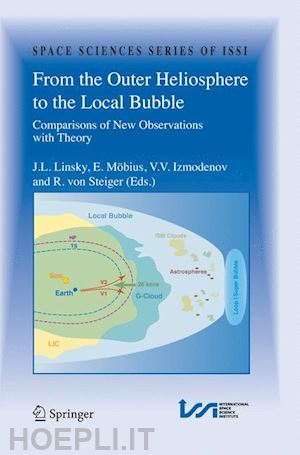
Questo prodotto usufruisce delle SPEDIZIONI GRATIS
selezionando l'opzione Corriere Veloce in fase di ordine.
Pagabile anche con Carta della cultura giovani e del merito, 18App Bonus Cultura e Carta del Docente
Knowledge about the outer heliosphere and the interstellar medium, which were long treated as two separate fields, has improved dramatically over the past 25 years as a consequence of recent developments: The discovery of interstellar pickup ions and neutral helium inside the heliosphere, the determination of the interstellar hydrogen distribution in the heliosphere obtained using backscattered solar Lyman-alpha radiation, the prediction and subsequent detection of the hydrogen wall just outside of the heliopause, the development of detailed global models for the interaction of solar wind plasma with the interstellar medium, and most recently, direct in-situ plasma and field measurements inside of the heliosheath. At the same time, our understanding of the nearby galactic environment, including the composition and dynamics of the warm gas clouds and hot gas in the local bubble, has benefited greatly from absorption-line spectroscopy using nearby stars as background sources and dynamic modeling. The present volume provides a synopsis of these developments organised into seven sections: Dominant physical processes in the termination shock and heliosheath, three-dimensional shape and structure of the dynamic heliosphere, relation of the plasmas and dust inside and outside of the heliosphere, origin and properties of the very local interstellar medium, energy and pressure equilibria in the local bubble, physical processes in the multiphase interstellar medium inside of the local bubble, and the roles that magnetic fields play in the outer heliosphere and the local bubble. The last theme is probably the most basic of all as magnetic fields play important roles in most of the phenomena discussed here. The volume concludes with four papers providing the "big picture" by looking at the time evolution of both the heliosphere and the local bubble, looking beyond the local bubble, and finally addressing the challenges in modeling the interface between the two media.











Il sito utilizza cookie ed altri strumenti di tracciamento che raccolgono informazioni dal dispositivo dell’utente. Oltre ai cookie tecnici ed analitici aggregati, strettamente necessari per il funzionamento di questo sito web, previo consenso dell’utente possono essere installati cookie di profilazione e marketing e cookie dei social media. Cliccando su “Accetto tutti i cookie” saranno attivate tutte le categorie di cookie. Per accettare solo deterninate categorie di cookie, cliccare invece su “Impostazioni cookie”. Chiudendo il banner o continuando a navigare saranno installati solo cookie tecnici. Per maggiori dettagli, consultare la Cookie Policy.